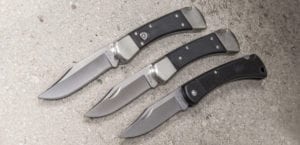This article appeared in Knife Magazine in September 2021.
Know Your Knife Laws – Knives in Outdoor Pursuits
By Daniel C. Lawson, Attorney and Knife Expert

Statutes in one-third of the United States contain a provision for hunting knives or the carry of knives for hunting. Other pursuits – primarily fishing and fur trapping are often included. The statutes in this category typically establish an exemption from general prohibitions regarding the carry or possession of specific knives. Some states restrict the concealed carry of fixed-blade knives or particular types of fixed-blade knives. Persons who are engaged in hunting, or traveling to or from a hunting location, may be exempt. In certain states, the possession of knives by convicted felons is restricted, subject to exceptions for hunting knives.
Automatic knives are widely misrepresented in the entertainment industry and, accordingly, widely misperceived. Few people associate such knives with outdoor pursuits. New York Penal Law § 265.01 provides that it is unlawful to possess a switchblade knife, and § 265.10 provides that it is illegal to manufacture or sell such knives. Notwithstanding § 265.20 (Exemptions) explicitly provides that those sections, among others in Article 265, “shall not apply to:
Possession of a switchblade for use while hunting, trapping or fishing by a person carrying a valid license issued to him pursuant to section 11-0713 of the environmental conservation law.
New York § 265.10 should not be viewed as some outlandish anomaly. Switchblade restrictions in New York State were first enacted in 1954. Until the last decade, New York was ranked second nationwide – after Pennsylvania – in its number of licensed hunters. It has since slipped to the top eight in the country for licensed hunters and the top ten for licensed anglers. The New York State Department of Environmental Conservation site also indicates a significant level of trapping:
There are about 10,000 trappers in New York. This number varies depending on the year and fur market conditions. New York State is one of the nation’s top producers of wild furs for the commercial fur trade. New York City remains a center for the production and marketing of fur garments.
The fact that New York State has exempted automatic knives for sporting and fur harvest activities should give significant credibility to the utilitarian value of such knives.
 Within the State of Maine, it is unlawful, per 25 M.R.S.A. § 2001-A, to conceal carry or display in a threatening manner any “bowie knife, dirk, stiletto or other dangerous or deadly weapon usually employed in the attack on or defense of a person.” These restrictions do not apply to “knives used to hunt, fish or trap.” The exemption is not contingent on the possession of a license or active engagement in hunting. It is equally available to “anti-hook and bullet” animal welfare advocates.
Within the State of Maine, it is unlawful, per 25 M.R.S.A. § 2001-A, to conceal carry or display in a threatening manner any “bowie knife, dirk, stiletto or other dangerous or deadly weapon usually employed in the attack on or defense of a person.” These restrictions do not apply to “knives used to hunt, fish or trap.” The exemption is not contingent on the possession of a license or active engagement in hunting. It is equally available to “anti-hook and bullet” animal welfare advocates.
The New Jersey hunting fishing exemption provides that the restrictions set forth in 2C:39-5. “Unlawful possession of weapons” does not apply to:
A person carrying a firearm or knife in the woods or fields or upon the waters of this State for the purpose of hunting, target practice or fishing, provided that the firearm or knife is legal and appropriate for hunting or fishing purposes in this State and the person has in possession a valid hunting license, or, with respect to freshwater fishing, a valid fishing license; (Italics supplied)
This statute mandates that a knife be appropriate, in addition to being legal. No standard or guidance is provided, though, for that term.
No statutory definition for “hunting knife” exists. The American Knife & Tool Institute (AKTI) has promulgated suggested definitions for some knife types, such as a “dagger.” A definition for a hunting or fishing knife is neither feasible nor appropriate. Hunting involves almost infinite variables, even within a given state. The same is true of fishing. Terrain, weather, the game being hunted, and access to transportation are all examples of these variables within states. The universe of knives suitable for outdoor pursuits is broad and indefinite.
The treatment of the hunting knife exception by the judiciary in Michigan – 3rd ranked in the country for licensed hunters – in its approach to a definition does not inspire confidence.
The Michigan statute applicable to fixed blade knives M.C.L.A. 750.227 provides:
A person shall not carry a dagger, dirk, stiletto, a double-edged nonfolding stabbing instrument of any length, or any other dangerous weapon, except a hunting knife adapted and carried as such, concealed on or about his or her person, or whether concealed or otherwise in any vehicle operated or occupied by the person, except in his or her dwelling house, place of business or on other land possessed by the person.
This statute is less than clear. When can one lawfully transport a hunting knife in a vehicle? The statute could be construed to mean that if a double-edged knife is “adapted” or used as a hunting knife, it is excluded from the concealed carry or vehicle restriction. The Michigan Supreme Court considered 750.227 in the case of People v Payne, 446 N.W.2d 629 (1989). The factual background was deemed irrelevant:
For the purposes of this appeal, the precise facts and circumstances under which the defendant was found to be in possession of the knife in question are irrelevant, and their recital would only be distracting. The issue before us is a threshold matter. The focus here is solely on whether defendant’s five-inch, double-edged, nonfolding knife can be called or described as a hunting knife.
Whether his knife was “adapted and carried” as a hunting knife, within the meaning of the hunting knife exception to the carrying concealed weapons statute . . . is a secondary consideration to be addressed only upon concluding that the knife at issue is a “hunting knife.” Then, and only then, do facts and circumstances such as, e.g., whether it was hunting season, whether the defendant was hunting at the time they were arrested, or going to or from a hunting excursion, become relevant.
The Michigan Court referenced a definition found in the 1966 Edition of Webster’s Third New International Dictionary:
hunting knife n: a large stout knife used to skin and cut up and sometimes dispatch game.
The dictionary definition did not specify a blade shape or style. Significantly, it states that a hunting knife may be used to “dispatch” game that would involve a stabbing wound readily delivered with a double-edged knife.
The Court disregarded the definition and focused on the less authoritative diagrams next to the definitions for “hunting knife,” “dagger,” and “stiletto”:
Additionally, Webster’s includes diagrams next to its definitions for “hunting knife,” “dagger” and “stiletto.” Both the dagger and stiletto are depicted as double-edged, straight-bladed knives. On the other hand, the hunting knife is shown typically as a heavy, wide-bladed knife with a single cutting edge that curves to a point.
This use of the diagrams afforded the Court the leeway to declare the statute as:
separating out hunting knives, as a specific category of knives, from all other types of knives whether listed specifically or generally in the statute, and even then, only if the hunting knife in question is “adapted and carried” as a hunting knife. (Italics in original)
A jury in Michigan empaneled to consider a criminal case under 750.227 would be instructed as to definitions for dirk, dagger, stiletto, and hunting knife. These instructions are written by a committee appointed by the State Supreme Court.
Those definitions per M Crim JI 11.5 and 11.9 provide:
A dirk is a straight knife with a pointed blade.
A dagger is a knife with a short, pointed blade.
A stiletto is a small dagger with a slender tapering blade
A hunting knife is a large, heavy, wide-bladed knife with a single cutting edge that curves up to a point. It is typically used to skin and cut up game.
The same dictionary used by the Court in People v Payne defines dirk and dagger:
dirk n 1: a long straight bladed dagger formerly carried esp. by the Scottish Highlanders.
dagger n 1a: a short weapon used for stabbing.
The Supreme Court Committee tended to deviate from the dictionary definition in the direction of creating broad, expansive definitions for dirk and dagger. A “straight knife with a pointed blade” can apply to a large class of knives. The same committee obviously attempted to confine the definition of a hunting knife. The committee eliminated the dispatch game element and prescribed a single-edge blade, and added the word “up” as in “curves up to a point.”
The drop point blade shape, quite commonly carried for hunting, would easily be considered a dagger and arguably not a hunting knife by a Michigan jury proceeding according to the State’s required instructions.
Those who study natural history and the fossil record inform us that humans first adapted cutting tools – knives – over 3 million years ago. Our ancestors used those knives for hunting and gathering. Today, we are still tweaking the design in search of a better knife.
The assertion by the Michigan Supreme Court that it has separated and defined a hunting knife lacks credibility. The American Knife & Tool Institute (AKTI) suggests that persons should have the freedom to select the knife – or tool – that best serves their needs and circumstances. Those specific activity exemptions currently existing in certain states regarding hunting or fishing knives should be viewed with skepticism, lest we reinforce the concept that knife possession or knife carry be based on what the State deems is needed or appropriate for that activity.
Finally, if anglers in the State of New York can be trusted – by law – with an automatic knife, why deny a farmer or tradesman that same benefit?
AKTI monitors legislative activity in all states and at the federal level to avoid dubious knife laws and advocate for rational alternatives. Sign up for monthly email news to Stay Informed about AKTI’s legislative initiatives and other valuable information.
Know the state knife laws where you live, work, and travel.